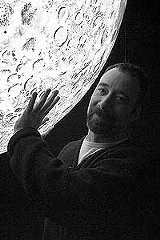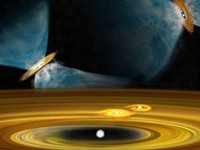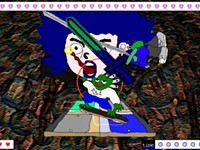[
{
"name": "500x250 Ad",
"insertPoint": "5",
"component": "15667920",
"parentWrapperClass": "",
"requiredCountToDisplay": "1"
}
]
The subjects of Adam Frank's research are thousands of light years away from the earth; he studies the life and death of distant stars.
But his work as associate professor of physics & astronomy, theoretical astrophysics and plasma physics at the University of Rochester, is ultimately about us --- how we got here and where we're going. Frank is an astrophysicist, but he has the ability to see his complex work in the context of poetry, philosophy, art and everyday life.
In the first installment of our interview, published in last week's City, Frank talked about our changing view of space over the centuries, the mysteries of dark matter and the possibility of life on other planets. In the interview's conclusion Frank discusses the latest ideas about multiple universes, the theory of everything, and the importance of astrophysics on practical and philosophical levels.
March 19
City:In the last couple of decades we've seen chaos theory, string theory, and a theory of everything. Could unlocking some of the secrets of space put us onto a unifying principle?
Frank: Not this kind of stuff. What's amazing is we have this theory called the Standard Model for sub-atomic or particle physics. What's the universe made out of? First we thought it's electrons and protons. Oh, no, there's a neutron. Then there's this other thing called a neutrino. The list kept growing. Finally people said it's mostly quarks that are the key fundamental subatomic building blocks of the Universe. Theories of everything are really theories about what the universe is built out of.
Obviously that has a link to cosmology because a zillionth of a zillionth of an instant after the Big Bang you'd better have a theory of everything or you're not going to understand how you evolved from this primordial fireball into what we see now. So we thought that quarks were everything then we realized there was a huge problem with trying to get this beautiful theory we have for the quarks to mesh with general relativity, Einstein's idea of gravity. String theory and theories of everything were theories that could unite gravity, and the forces that govern quarks and electrons.
City:How do you define string theory?
Frank: On a certain level it's a really simple idea. We're all taught in high school that matter's made out of little point particles. String theory says that's wrong; the universe is made out of super tiny strings of energy. Instead of saying everything's a little billiard ball, if you make it into a string, suddenly a lot of the problems that come about from trying to unify gravity with the other three forces look like maybe they'll go away.
Something more radical comes out because a point particle is zero dimensions, and a string is one-dimensional. People realized, in order to get this thing to work, we need a 10- or 11-dimensional universe. Also, maybe we don't just have strings. We may have membranes in this universe. Our three dimensions is a sheet, like a drumhead, in this higher-dimensional universe. Once people started to think about strings they were able to start thinking about two, four, or six-dimensional membranes, and that, mathematically, starts to solve some problems.
City:In terms of unifying things on a microcosmic, macrocosmic level, the way humans are created --- sperm swimming through a tube and piercing an egg, and the multiplication of cells --- descriptions of the Big Bang and birth of stars seem related.
Frank: I'm a little bit schizophrenic because I always want to be very careful in using or interpreting science. In some sense what science gives you is a way of calculating things, a way of asking questions and determining whether your answers are meaningful. But, as a human being, one of the reasons I like what I do is because it's the story of the birth and death of stars. There's a drama there which, emotionally, I'm attached to. But is that showing us that there really is a true link or is it speaking to the way we interpret the world?
There's a great quote by Muriel Rukeyser, an amazing poet who understood science better than a lot of scientists. She said the universe is not made out of atoms, it's made of stories. What I'm interested in is not so much what science says, but how it's possible we can say it. How is it possible in science or art that we can recognize truth in its different forms? So it's a good example that you bring up. It's not clear to me that the universe does recapitulate births and deaths. I'm not sure if science is telling us about an objective world that's out there or telling us about our dialogue with that world. Clearly something is out there but how much of it is the filter of the nature of our consciousness?
City:But there's a universal concept there; something as large and distant as a star has the same cycle as we do.
Frank: That's true. Where does that come from? There's a very deep principle in that and it's the arrow of time. You can assemble something and it will work for a while, consume and generate energy, but it always has to run down. Time always goes in one direction.
City:So there's at least one universal principle.
Frank: That's right, but there may be more than one universe. That's one of the other radical things that we're dealing with now, the possibility that there are many universes. People now talk about the multi-verse --- that we live in kind of a bubble, that there may have been multiple Big Bangs, or there may have been many universes that came out of the Big Bang and we're in one bubble universe. This is all speculation right now.
City:Lately, I've seen the term "parallel universe" showing up in serious articles.
Frank: It's amazing --- ideas that 50 years ago were considered science fiction --- now people talk about an ensemble of universes, the idea of many possible universes evolving. They may have different physical laws than the ones that we ended up with. Instead of four forces, maybe some of them have five forces.
City:Speaking of science fiction, how does an astrophysicist react to the Raelians' talk of clones from outer space or UFOs in general?
Frank: The first reaction is always, oy vay! Science very much plays the role of religion in the culture in the sense that scientists are kind of the professional priests that you turn to for answers.
Many years back, Kip Thorne, the master of general relativity, was doing serious scholarly work about whether you could use a black hole to travel backwards in time. He gave a talk at the University of Washington in Seattle where I did my PhD. He's a major big-wig, so after the talk all of the grad students were crowding around to ask him questions.
Then a guy over to the side, an obvious nutcase with a pile of newspapers he'd been carrying around for months, blurted out: "God is going to appear in Arizona in a week!" One of the graduate students just stepped in front of him, just shut him out like he didn't exist anymore.
I thought, isn't this amazing; 500 or 1,000 years ago, the guy with the religious prophesy would have been the one that we all wanted to take out to dinner. The guy talking about time travel would be the nut case. But in our culture, Kip Thorne writes the book, gets the Guggenheim fellowship, and gets taken to dinner. So the fact that people look for revelation in science --- the aliens are here waiting to show us the way to the new millennium --- is something I'm not surprised by.
City:Popular culture doesn't seem to differentiate between the valid and invalid.
Frank: What science and art both ask of you is honesty. If you're an artist and you produce crap, you've got to say that was lousy. You've got to go back and start again. I heard a musician say, "The thing I need from myself is excellence." That's what I require of myself and my students. What science asks for is to be honest about the chain of reasoning. Does this idea make sense? There are so many ways that UFOs don't make sense. You've got the whole universe to go to, why would you come here?
City:The irony is, the real space story is far more strange and fascinating.
Frank: If people looked at the world --- the sun rising --- the world is so incredibly beautiful and it's so rich. We don't need eight-headed aliens to have a sense of how extraordinary the world is. Somebody once said we are the most entertained generation there ever has been. We're so distracted and if we just looked around, we'd see that there are more than enough things that are miraculous and worthy of attention.
City: After you've worked for hours on astrophysics, how does it feel to come back down to earth?
Frank: I love it! I'm a café physicist. I did my whole thesis work in a café in Seattle. I love being out in the world and then dropping into the world of science. My wife is an excellent pianist and she describes this when she's practicing. Five hours, you put your head down, start the work, and you're suddenly like, Whoa! Where'd the time go?
I often imagine the world of mathematical physics as being in the desert, bone dry; a beautiful, pristine, silent, quiet, incredibly clear world. I love doing it in cafés because there's that sort of din of life --- people talking --- around you. I love when, sort of, the elevator comes up and you're back. It's all still here. You can use science as a way to hide, but it's nice to visit that world and come back here.
City:When you're falling asleep are you preoccupied with theories?
Frank: Not so much falling asleep. But the cool thing about being trained as a scientist is you can't stop noticing. I imagine it's very similar to a visual artist who's always seeing the world in terms of variations in color. I look at a tree and, because I know a little bit about chaos, I'll start wondering why that choice of branching occurred. Since I'm a fluid dynamicist --- I mainly study fluids --- just watching the toilet flush is fascinating. I'll be at dinner with somebody, pour the cream in the coffee, and then get mesmerized watching the convection patterns when the cream comes up. It's hard because you want to go, oh, that is so cool! And the people you're with are looking at you like, who cares?
City:I remember seeing a comparison of those multiple universes you talked about with bubbles in a pot of boiling water, coming from nowhere and getting bigger and bigger. But people who are not fascinated might ask, what is the relevance of this to our lives?
Frank: Astrophysical research doesn't really have any practical value, but by doing astrophysical research we end up with the Internet. The web browser was developed by people doing astrophysical research. There are all kinds of spin-offs. The laser was blue-sky research; somebody was trying to figure out whether physical systems could act this way, and in the end you come up with something that drove a zillion-dollar business.
City:Could the kind of energy you witness in space be duplicated to provide energy on earth?
Frank: We're working on that. We have the world's largest laser on the University of Rochester campus and it's used to study fusion. They take a tiny palette of hydrogen gas, hit it, and try to get it to fuse, because that's what powers the sun. There's an effort to harness energy for civilian needs to give us power so we can be free of oil.
We're starting to use that laser to create scale models of the stuff that happens in astronomy. Some of those gas clouds are expanding, moving at 500 kilometers a second. We're trying to create jets of gas that move at that speed and test some of the things that we could only test before with computer simulations.
City:What does astrophysics mean to us as individuals?
Frank: Astrophysics and astronomy are about awe and wonder, and about the sacred. The night sky is sacred to us because it embodies something that calls to something more. There's a deep mythological quality to it. Even if we study it through the lens of highly technical physical theories, it's still opening something in us that needs to be opened because the truck of the day-to-day business is such that you can so easily get lost in it and never look up. It's the same function that art plays, to get us to look beyond our individual lives.
Every now and then you'll see one of these beautiful images from the Hubble Space Telescope of a dying star on the cover of Time magazine. Well that's one week that we didn't have the war in Iraq being shoved in our face. For one week we have a sense of how grand and beautiful the universe is. We're always in the profane world and this brings us into the sacred.
City:Do you subscribe to a linear evolutionary theory of the universe or more of a random, contingency theory?
Frank: There's an order in the sense of the laws of physics, but randomness may play a very important role. For example, none of the other planets in the solar system have a big-ass moon like we do. That moon may have been absolutely crucial in allowing life to evolve because the earth's spin axis has hardly moved. Day and night and the seasons stay pretty much the same. Mars's spin access has sometimes pointed it straight at the sun. When that happens, any chance for a stable climate is gone. If the North Pole pointed directly at the sun for a million years, that's the end of it.
So an accident like having the gravitational pull and stabilizing influence of a big moon may make all the difference. For the universe as a whole, it may be more evolutionary.
We've also realized that comet and asteroid collisions are probably fundamental to whether you can get life. It may be that life didn't form once on the earth; it may have formed a number of times. The surface of the planet may have been sterilized with really large cometary or asteroid impacts. And if a solar system does not have a Jupiter in the right place --- Jupiter is like a giant vacuum for comets and asteroids --- we would have gotten hit a lot more.
City:On a timeline, you have the Big Bang, the evolution of the universe, and the relatively short period of the earth's formation. Then you have the sun burning out in a couple billion years and life on earth ending. Our knowledge enables us to see the beginning, but we can also see the end. Then you really start to wonder what it all means.
Frank: Let's say the universe is going to expand forever, which means that everything is going to get farther apart until you won't get any more collapse of objects. You're eventually not going to be able to make any new stars. If there are no new stars, there are no new energy sources and there will be no new life forming.
So, if you look at that long line from the birth of the universe to whatever, there's only a brief window of a few billion years when you can have life. If the universe has another hundred or 500 billion years, most of it's going to be lifeless because there's only this time when the stuff in the universe is close enough together that we've been able to make stars. We may actually be living in this little sliver of time when the universe could look at itself.
City:The ultimate birth and death.
Frank: It's really that ultimate death that's hard to grasp, the idea that it expands forever and becomes thinner and thinner until there's nothing there, because everything is so spread out.
Speaking of Adam Frank, cosmos
Latest in Culture
More by Ron Netsky
-

Album Review | 'Bizet: Carmen in Jazz'
Mar 26, 2024 -
'To Swing Is the Thing" by Mike Melito
Aug 10, 2023 - More »




